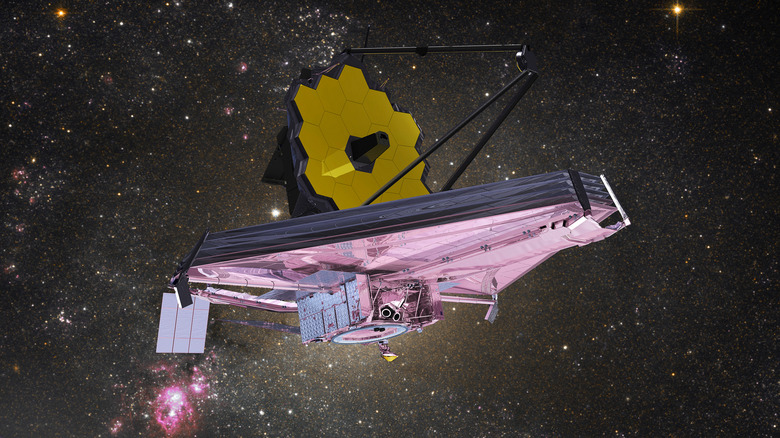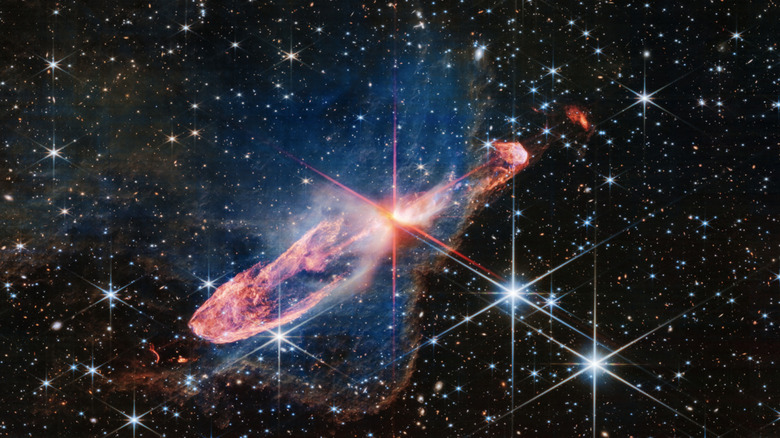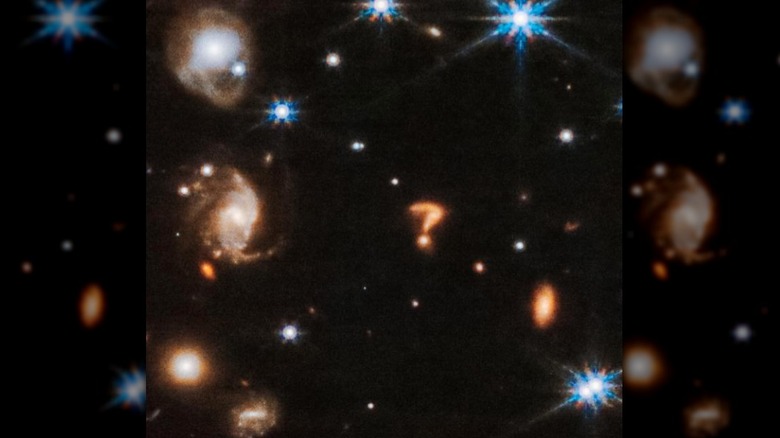What The Question Mark Seen In Space Tells Us About Galaxies
On Wednesday, June 26, 2023, James Webb Space Telescope (JWST) scientists at the European Space Agency (ESA) released an image of Herbig-Haro 46/47, two young stars forming about 1,500 light years from Earth in the Vela Constellation, according to Space.com. In the corner of the infrared composite image (seen below), some noticed what appeared to be a question-mark shape floating in deep space. It wasn't, of course, a question mark at all, but likely two galaxies colliding, an important step in a galaxy's development — even our own Milky Way — which researchers have seen before, NPR reports.
Though it's too soon and too far away to know for certain, ESA communication program officer Kai Noeske told NPR, "[The question mark] looks like a group or a chance alignment of two or three galaxies. The upper part of the question mark looks like a distorted spiral galaxy, maybe merging with a second galaxy." And the dot on the question mark could be "a smaller spherical galaxy," ESA scientist Nora Luetzgendorf added. And causing the question mark-like effect, she said — a hooked line and a point — was likely "tidal interaction" between the two. Most crucially, though, as James Webb scientist Macarena Garcia Marin told NPR, "If this is a galaxy merger, its relevance would be to see how it fits in what we know about mergers and their importance for galaxy evolution."
Other galaxy mergers look a little like question marks
As mentioned, if what was captured in the Herbig-Haro 46/47 image is in fact galaxies merging, the moment has been seen before and in earlier pictures posted on Hubblesite, it can sometimes look a bit like a question mark because of what's called the tidal tail, a type of tidal interaction. According to COSMOS from Swinburne University of Technology, tidal tails happen when galaxies come into close proximity with one another, and their gravitational pull causes a streak of stars and gas to extend in advance and in the wake of each one. Tails most often happen as a much larger galaxy passes close to a smaller one, per astrobites, but tidal features actually occur in a number of different shapes, depending on the kinds of galaxies interacting.
What's important about tidal tails is less how they form but how they move and how that movement relates to surrounding dark matter. What's more, they not only teach us what happens when galaxies collide, they offer insight into how stars form, as the disrupted gas from galaxies in close proximity to one another contributes to how stars are born, astrobites writes.
Tidal tails are just one plausible explanation
Though likely a galaxy merger, Chris Britt of Space Telescope Science Institute (STSI) which operated the Webb telescope told The New York Times, that the image in the Herbig-Haro 46/47 composite is too far away to know for sure what caused it. "But there are some similar looking galaxy mergers that have been seen closer to us," Britt said. And speaking with SPACE.com, Illinois State University assistant physics professor Matt Caplan added, "Given the color of some of the other background galaxies, this doesn't seem like the worst explanation. Despite how chaotic mergers are, double-lobed objects with curvy tails extending away from them are very typical."
On that note, an STSI representative told SPACE.com, "Additional follow-up would be required to figure out what it is with any certainty. Webb is showing us many new, distant galaxies — so there's a lot of new science to be done!" On the tendency for people to recognize familiar objects in space, James Webb scientist Macarena Garcia Marin said (via NPR) "I think we all enjoy finding familiar shapes in the sky; that creates a deep connection between our human experience and language in this case (a question mark!) and the beauty of the universe surrounding us."


